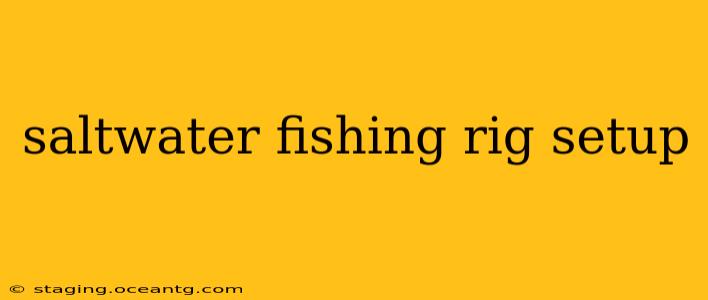Saltwater fishing offers thrilling challenges and rewarding catches, but success hinges on proper rig setup. Choosing the right gear and assembling it correctly significantly impacts your chances of landing that trophy fish. This comprehensive guide will walk you through various saltwater fishing rig setups, addressing common questions and providing expert tips for maximizing your fishing success.
What are the most common saltwater fishing rigs?
Several rigs cater to different saltwater fishing scenarios. The most common include:
-
Bottom rigs: These are designed to keep your bait or lure close to the bottom, ideal for targeting bottom-dwelling fish like grouper, snapper, and flounder. Common bottom rigs include Carolina rigs, Texas rigs (often modified for saltwater), and simple weight-and-hook setups. The specific setup often depends on the bottom structure (sand, rock, weed beds) and the type of bait or lure used.
-
Float rigs: These keep your bait suspended in the water column, perfect for targeting pelagic species like mackerel, bonito, and some types of tuna. Float rigs use a bobber or float to hold your bait at a desired depth. The size of the float dictates the depth and the weight of the rig.
-
Trolling rigs: Used for targeting actively swimming fish, trolling rigs are deployed from a moving boat. They often feature a variety of lures or baits trailed behind the boat at different depths and speeds. This is common for targeting game fish like marlin, wahoo, and tuna.
What is the best saltwater fishing rod for beginners?
For beginners, a medium-power, medium-action spinning rod is a versatile choice. This type of rod offers a good balance of sensitivity and power, allowing you to handle a variety of species and tackle sizes. Look for a rod length between 6.5 and 7.5 feet. The material (graphite or fiberglass) is less crucial than the action and power for a beginner.
What type of line is best for saltwater fishing?
Braided line is extremely popular for saltwater fishing due to its high strength-to-diameter ratio, sensitivity, and abrasion resistance. However, it can be more difficult to cast and is more visible to fish than monofilament. Monofilament line is more forgiving, casts well, and is less visible to fish but stretches more and is less durable compared to braided line. Fluorocarbon line is the least visible to fish, offering good strength, and abrasion resistance; however, it can be expensive.
The best line choice depends on your target species, fishing style, and budget. Experimenting with different line types will help you determine what works best for you.
What are the best hooks for saltwater fishing?
The ideal hook size and style vary greatly depending on the target species and the type of bait or lure being used. For example, larger hooks are needed for larger fish, while smaller hooks are used for smaller fish or delicate baits. Look for corrosion-resistant hooks (stainless steel or titanium) to withstand saltwater conditions. Circle hooks are commonly used as they minimize deep hooking and improve catch-and-release opportunities.
What type of reel is best for saltwater fishing?
A good quality saltwater fishing reel is essential for combating the corrosion and power needed to land strong saltwater fish. Consider spinning reels for their versatility and ease of use or conventional reels for greater power and casting distance. Look for reels with strong drags, sealed bearings (to prevent saltwater intrusion), and a robust build.
How do I choose the right weight for my saltwater fishing rig?
Weight selection depends on several factors, including the depth of the water, current speed, type of bait or lure, and target species. In stronger currents or deeper water, heavier weights are needed to keep your bait or lure in place. Experimentation and observation of what others are using in your fishing area is helpful.
How do I tie a saltwater fishing knot?
Many reliable knots exist for saltwater fishing. Some of the most popular include the Palomar knot (simple, strong, and versatile), the improved clinch knot (another popular and strong all-around knot), and the Bimini twist (for braided line to increase strength and reduce wind knots). Practice tying these knots to master them. There are many excellent videos demonstrating the correct way to tie these knots.
By understanding these fundamental aspects of saltwater fishing rig setup and adapting them to your specific target species and fishing conditions, you’ll significantly increase your chances of a successful and enjoyable fishing trip. Remember to always practice responsible fishing and respect the environment.
